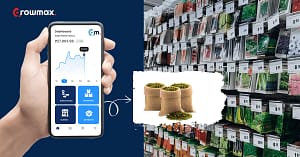A renowned quote by Tamunobelema William, “Money is the lifeblood of any business entity”. How and why is this quote important to consumer goods brands? The brands need to comprehend it in this way: the smoother their supply chain process is, the higher the order fulfillment ratio will be, ultimately improving their revenue model.
To ensure that the intended recipient receives the goods at the right place and time, companies should focus on the movement of their products from their warehouses to the market through intermediaries. This will help to enhance the brand’s reputation and revenue.
The entire journey of the supply chain involves three stages :
- Primary Sales
- Secondary Sales
- Tertiary Sales
The manufacturer/company, distributor, and retailers actively collaborate to make goods available to customers. Each stakeholder plays a crucial role in the three levels of sales.
Stage involved in the sales process.
What is Primary Sales in the Consumer Goods Industry
It is an initial part of interaction in the supply chain process, which takes place between the brand and the distributor, where goods are moved from the manufacturer’s warehouse to the distributor’s inventory.
The manufacturer invoices the distributor for the number of goods it orders at an SRP (suggested retail price), which ultimately adds up the revenue and profit of the company.
Whether the manufacturer’s product will reach the market depends upon certain factors like brand reputation and image in the market, the wideness of the distribution network, and profitability in the product category to distributors. In conclusion, primary sales are the foundation of the sales process.
After all, the demand at a customer level decides the execution of primary sales between the manufacturer and the distributor. If customers are not demanding, then, “Why would distributors place orders with the manufacturer”?
For instance, HUL sells its Dove soap to a regional distributor that supplies to supermarkets and grocery stores, a perfect example of primary sales.
What are Secondary Sales in the Consumer Goods Industry
Secondary sales are the transactions between distributors, wholesalers, or retailers. They continue primary sales and involve fulfilling orders at a discounted price.
Secondary sales are more important to brands than primary sales because they determine the occurrence of direct sales. Retailers will not place orders with distributors if customers do not demand the brand’s goods. This disrupts primary sales.
Retailers decide to stock a brand’s products based on the brand’s equity, stock availability, and credit with lucrative trade promotions.
Also Read :- The Hidden Threats of Poor Secondary Sales Visibility in the Seed Industry
Tertiary Sales in the Consumer Goods Industry
In the general trade, retailers sell products to customers in the tertiary stage of the sales chain for consumer goods brands. They do so at a Maximum Retail Price (MRP) following a 3-tier distribution process.
To execute sales at the retailer level, brands need many strategies like merchandising, advertising, special offers, and discounts to remain relevant in the consumer goods market; as the customers rapidly flip in today’s market, they hesitate to buy such products that aren’t marketed well.
Some common challenges consumer goods brands deal with.
I am going to highlight the unsolicited bottlenecks that consumer goods brands handle in the process of executing primary and secondary sales, which cost them valuable time and money, which they cannot lose in this ongoing competitive environment:
Lack of visibility:
Consumer goods brands, at the primary level, deal with the invisibility of overstock and understock in their inventory, which causes trouble in the process of taking up orders from the distributors or retailers in case of secondary sales.
Inessential cost:
The excess inventory leads to an increase in storage costs, odds of spoilage, pressure to discount, burning of cash flow, etc. It becomes a pain in the neck when the manufacturer has numerous distribution channels, and it is complex to manage each manually.
Lack of traceability:
There is an absence of a central database as brands cannot trace the accurate number of goods shipped to distributors to retailers (secondary sales are too critical to be drafted, though)
Issues in decision-making:
Brands need to make better, structured, and informed decisions due to the inability to access concurrent insights about the performance of their sales reps on the field, leading to a poor reward system.
Outdated methods:
Many consumer goods brands are managing their operational activities manually or stuck to the traditional ways of handling them, making them struggle to get efficient and effective output from their efforts.
No knowledge of market dynamics:
It is challenging to analyze the current trends and patterns in the consumer goods market due to the lack of data-driven tools, which is causing the brands to suffer from dynamic market conditions, leading to revenue loss
Week connection:
The impotence of monitoring a retailer’s inventory level leads to invisibility into secondary sales. The connectivity between distributor and retailer crumbles once goods are shipped to the latter.
Fail to maintain relations:
Consumer goods brands face the biggest challenge of maintaining relationships with all their distributors. Distributors don’t share information about new products, promotions, or marketing initiatives, causing confusion due to the lack of transparency between them.
Solutions to all challenges that brands go through.
Distribution management software (DMS) will help consumer goods brands streamline the process of sales activities, be it primary or secondary, to get efficient output. Here are the benefits of using DMS and the areas in which it will benefit:
Inventory management in real-time
Brands get to look into their inventory level, whether overstock or stockout, instantaneously. The DMS system will track the inventory of the brand or the distributor to help them make actual-time and data-driven decisions, leading to business triumph.
Refining order processing
Businesses can access real-time order insights. They can do this by automating workflows, streamlining communication, and providing visibility into order processing status.
Using a DMS system to collect information from various sources can help businesses make informed decisions about market trends accurately.
Generative reports
The software generates reports automatically. The reports include sales performance, resource allocation, promotions, and areas for improvement. Brands use these insights to personalize their supply chain activities.
Settlement of claims and returns
Onboarding the DMS system makes it easy for distributors to resolve claims. This includes both internal and external claims from employees and customers.. The same goes for the settlement of returns. For instance, DMS can monitor the returns of excess inventory from retailers or distributors, which eventually simplifies the operational processes.
Final Words
Moreover, all consumer goods brands should utilize software solutions, such as distribution management systems or sales force automation. These tools can help streamline the distribution process, optimize sales activities, and enhance overall productivity.. These solutions can help them streamline operations and field force, enabling them to achieve their business goals. Brands that don’t evolve will suffer and struggle to keep up with the competition. Therefore, brands must invest in technology to stay relevant and succeed in the dynamic consumer goods market.




